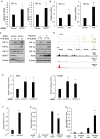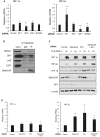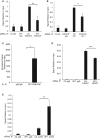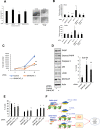SINHCAF/FAM60A and SIN3A specifically repress HIF-2α expression
- PMID: 29784889
- PMCID: PMC6024822
- DOI: 10.1042/BCJ20170945
SINHCAF/FAM60A and SIN3A specifically repress HIF-2α expression
Abstract
The SIN3A-HDAC (histone deacetylase) complex is a master transcriptional repressor, required for development but often deregulated in disease. Here, we report that the recently identified new component of this complex, SINHCAF (SIN3A and HDAC-associated factor)/FAM60A (family of homology 60A), links the SIN3A-HDAC co-repressor complex function to the hypoxia response. We show that SINHCAF specifically represses HIF-2α mRNA and protein expression, via its interaction with the transcription factor SP1 (specificity protein 1) and recruitment of HDAC1 to the HIF-2α promoter. SINHCAF control over HIF-2α results in functional cellular changes in in vitro angiogenesis and viability. Our analysis reveals an unexpected link between SINHCAF and the regulation of the hypoxia response.
Keywords: HIF-2histone deacetylases; SIN3A; SP1; hypoxia; hypoxia-inducible factors; transcription.
© 2018 The Author(s).
Conflict of interest statement
The Authors declare that there are no competing interests associated with the manuscript.
Figures






Similar articles
-
Family with sequence similarity 60A (FAM60A) protein is a cell cycle-fluctuating regulator of the SIN3-HDAC1 histone deacetylase complex.J Biol Chem. 2012 Sep 21;287(39):32346-53. doi: 10.1074/jbc.M112.382499. Epub 2012 Aug 3. J Biol Chem. 2012. PMID: 22865885 Free PMC article.
-
The developmental regulator protein Gon4l associates with protein YY1, co-repressor Sin3a, and histone deacetylase 1 and mediates transcriptional repression.J Biol Chem. 2011 May 20;286(20):18311-9. doi: 10.1074/jbc.M110.133603. Epub 2011 Mar 29. J Biol Chem. 2011. PMID: 21454521 Free PMC article.
-
The SIN3A histone deacetylase complex is required for a complete transcriptional response to hypoxia.Nucleic Acids Res. 2018 Jan 9;46(1):120-133. doi: 10.1093/nar/gkx951. Nucleic Acids Res. 2018. PMID: 29059365 Free PMC article.
-
Protein kinase Calpha-induced derepression of the human luteinizing hormone receptor gene transcription through ERK-mediated release of HDAC1/Sin3A repressor complex from Sp1 sites.Mol Endocrinol. 2008 Jun;22(6):1449-63. doi: 10.1210/me.2008-0035. Epub 2008 Mar 27. Mol Endocrinol. 2008. PMID: 18372343 Free PMC article.
-
Sin3: insight into its transcription regulatory functions.Eur J Cell Biol. 2013 Aug-Sep;92(8-9):237-46. doi: 10.1016/j.ejcb.2013.09.001. Epub 2013 Oct 9. Eur J Cell Biol. 2013. PMID: 24189169 Review.
Cited by
-
Transcriptional profiling of lung cell populations in idiopathic pulmonary arterial hypertension.Pulm Circ. 2020 Feb 28;10(1):???. doi: 10.1177/2045894020908782. eCollection 2020 Jan-Mar. Pulm Circ. 2020. PMID: 32166015 Free PMC article.
-
Long-Distance Repression by Human Silencers: Chromatin Interactions and Phase Separation in Silencers.Cells. 2022 May 5;11(9):1560. doi: 10.3390/cells11091560. Cells. 2022. PMID: 35563864 Free PMC article. Review.
-
Characterization of gene expression profiles in the mouse brain after 35 days of spaceflight mission.NPJ Microgravity. 2022 Aug 10;8(1):35. doi: 10.1038/s41526-022-00217-4. NPJ Microgravity. 2022. PMID: 35948598 Free PMC article.
-
TNFSF14/LIGHT, a Non-Canonical NF-κB Stimulus, Induces the HIF Pathway.Cells. 2018 Aug 8;7(8):102. doi: 10.3390/cells7080102. Cells. 2018. PMID: 30096845 Free PMC article.
-
Induced pluripotent stem cell-derived extracellular vesicles overexpressing SFPQ protect retinal Müller cells against hypoxia-induced injury.Cell Biol Toxicol. 2023 Dec;39(6):2647-2663. doi: 10.1007/s10565-023-09793-x. Epub 2023 Feb 15. Cell Biol Toxicol. 2023. PMID: 36790503
References
-
- Muñoz I.M., MacArtney T., Sanchez-Pulido L., Ponting C.P., Rocha S. and Rouse J. (2012) Family with sequence similarity 60A (FAM60A) protein is a cell cycle-fluctuating regulator of the SIN3-HDAC1 histone deacetylase complex. J. Biol. Chem. 287, 32346–32353 10.1074/jbc.M112.382499 - DOI - PMC - PubMed
Publication types
MeSH terms
Substances
Grants and funding
LinkOut - more resources
Full Text Sources
Other Literature Sources
Research Materials
Miscellaneous

